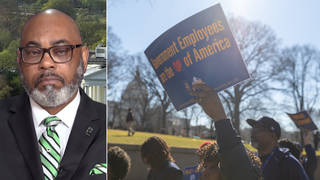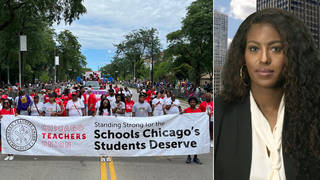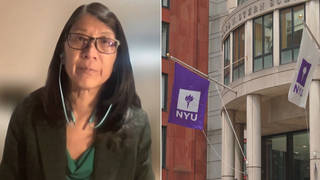
Topics
Guests
- Yoruba Richendirector and writer of the documentary The Green Book: Guide to Freedom and director of the documentary program at the Newmark Graduate School of Journalism at CUNY.
The Academy Awards take place this weekend, and one of the top contenders is the movie “Green Book,” which has renewed interest in the history of “The Negro Motorist Green Book.” So today we look at a remarkable new documentary called “The Green Book: Guide to Freedom,” that offers a real look at the history of a travel guide that helped African Americans safely navigate Jim Crow America. The film premieres Monday on the Smithsonian Channel and details the violence, insults and discrimination black travelers faced on the road, as well as the pride and sense of community they felt in the safe spaces they created around the country, in the form of restaurants, hotels and vacation retreats. We feature excerpts and speak with writer and director Yoruba Richen, professor in the documentary program in the Newmark Graduate School of Journalism at CUNY.
Transcript
AMY GOODMAN: This is Democracy Now! I’m Amy Goodman. The Academy Awards take place Sunday. One of the top contenders for a number of Oscars—for best picture, best actor, supporting actor, screenplay, editing—is the movie Green Book. The film is inspired by the true story of a tour of the Deep South by the African-American classical and jazz pianist Don Shirley, played by Mahershala Ali, and his driver, Tony Lip, played by Viggo Mortensen.
The movie has renewed interest in the history of The Negro Motorist Green Book. And today we look at a remarkable new documentary that offers a real look at the history of a travel guide that helped African Americans safely navigate Jim Crow America. It details the violence, the insults, the discrimination black travelers faced on the road, as well as the pride and sense of community they felt in the safe spaces they created around the country, in the form of restaurants, hotels and vacation retreats. The film is called The Green Book: Guide to Freedom. This is the trailer.
MARQUETTE FOLLEY: Very bad things happened to African Americans. Going down a dark country road, there was a sense of apprehension. You could actually be lynched.
YORUBA RICHEN: Smithsonian Channel presents the real story behind the book.
UNIDENTIFIED: The Green Book was a way to understand how you could get from A to B safely.
YORUBA RICHEN: That became a roadmap.
UNIDENTIFIED: Right when you open up, it says, “Know your rights.” And it goes state by state.
YORUBA RICHEN: For some of the most significant people, successful businesses and most important political milestones of the 20th century.
UNIDENTIFIED: Owning an automobile was a big deal.
JAMON JORDAN: Having a car meant something. It meant that you had arrived.
UNIDENTIFIED: Regular people populating something called middle class?
UNIDENTIFIED: There were all kinds of businesses listed, just what you would find in a AAA guide, but also very telling in terms of how many areas black people were shut out of.
UNIDENTIFIED: It uncovers a hidden truth about the African-American community. It allows us to really just simply embrace the genius of us.
UNIDENTIFIED: The Negro Travelers’ Green Book.
MARQUETTE FOLLEY: The guide to travel and vacations.
UNIDENTIFIED: Travel-wise people.
RON HANDY: Carry your Green Book with you.
UNIDENTIFIED: You may need it.
AMY GOODMAN: That’s the trailer for The Green Book: Guide to Freedom. The film premieres Monday on the Smithsonian Channel.
For more, we’re joined here in our New York studio by its writer and director, Yoruba Richen, a professor in the documentary program in the Newmark Graduate School of Journalism at CUNY. She also happens to be a former Democracy Now! producer.
It’s great to have you back here, Yoruba.
YORUBA RICHEN: It’s great to be here, always.
AMY GOODMAN: Congratulations on this film.
YORUBA RICHEN: Thank you. Thank you.
AMY GOODMAN: Talk about the history and what inspired you to do this film.
YORUBA RICHEN: So, let’s see. There’s so much history within the pages of The Green Book. The Green Book was created and first published in 1936 by a man named Victor Hugo Green. He was a postal worker based in Harlem. And he had the idea for the book because of a Jewish friend of his had a guide for the Catskills for Jewish families, where they could go in the Catskills. And he looked at that, and he said, “Hey, this would be a great idea. This is something that the black community needs.” He also had a—was married to a woman named Alma, who lived in Virginia, and they would travel down to Virginia. And he, you know, experienced all the things that African Americans experienced at that time in terms of traveling. And so he created The Green Book.
AMY GOODMAN: You narrate this film, I want to take it—go back to the film, as you describe and show this history of The Green Book.
YORUBA RICHEN: Victor Green was a postal worker from Harlem, New York, one of the fastest-growing African-American communities in the country. But even in his own neighborhood, African Americans were unwelcome at many hotels and other establishments. And at Harlem’s famed nightclubs, such as the Cotton Club, where top black entertainers, like Lena Horne and Duke Ellington, packed the house every night, blacks were not allowed to sit in the audience. In 1936, Green created and published the first Negro Motorist Green-Book, which listed businesses where black customers were welcome.
THE GREEN BOOK 1948: The idea of The Green Book is to give the Negro traveler information that will keep him from running into difficulties, embarrassments and to make his trips more enjoyable.
YORUBA RICHEN: The Green Book started out only listing locations in New York, mainly in Harlem. Two of the most prominent were the Hotel Theresa and the YMCA, which served as one of Harlem’s most important recreational and cultural centers. During the 1930s, dancers from the Cotton Club rehearsed at the YMCA. And many famous luminaries, such as writer Langston Hughes and boxer Joe Lewis, stayed there. But The Green Book would soon outgrow Harlem. And by the time it ended publication, it had become more than just a travel guide. It had become a roadmap to some of the most significant people, successful businesses and most important political milestones of the 20th century.
HENRIE MONTEITH TREADWELL: It’s important to have everyone in this nation examine the significance of The Green Book. If you don’t see the history, if you don’t see where it was, how can you say it happened?
YORUBA RICHEN: Eventually, The Green Book would list more than 9,500 places between its pages. Today, only about a third of those sites are still standing.
HENRIE MONTEITH TREADWELL: We need to find those places, and we need to see them, and we need to revere what they meant, because they made all the difference to our survival.
THE GREEN BOOK 1947: Carry your Green Book with you. You may need it.
AMY GOODMAN: An excerpt of the Smithsonian’s new documentary The Green Book: Guide to Freedom. Our guest is Yoruba Richen, who is the filmmaker who made this documentary. “You may need it.” This was not just about where you could go to have fun; this was about where you could go to ensure you would survive.
YORUBA RICHEN: Absolutely, absolutely. Traveling during that time, for African Americans, was, to say the least, a dangerous proposition. Not only was there segregation in the South, places where African Americans obviously were not allowed to go, to eat, to sleep, but also the North and the West. So, you know, there’s this mythology that racism and segregation is confined to the South, or was confined to the South. That’s not true. The North and the West had the majority of what we call “sundown towns,” places where African Americans had to get out, had to leave town. There were maybe signs, a bell might be rung, for African Americans to leave the town. They were not welcome, and there was the potential for violence.
AMY GOODMAN: After midnight. In the daytime, they could work there.
YORUBA RICHEN: Yes, they could work there, and then they had to leave.
AMY GOODMAN: In fact, that was also referenced in the Hollywood film Green Book.
YORUBA RICHEN: Absolutely, yeah.
AMY GOODMAN: Which has been criticized for various reasons—
YORUBA RICHEN: Right.
AMY GOODMAN: —the perspective it was told from, the white driver’s son—it was based on his book—and not consulting Don Shirley’s family.
YORUBA RICHEN: Yeah.
AMY GOODMAN: This remarkable pianist, classical, jazz, who took this tour in 1962 through the South. But you definitely have the sense of violence he faced. And his going to—well, talk about, in the Hollywood film, the places he went to, versus, well, all the places that are documented in The Green Book.
YORUBA RICHEN: Yeah, I mean, that was one of the most frustrating parts for me and for many people watching the Hollywood film, is that the film is called The Green Book—The Green Book is only a small part of the film—but the places that they went to were really not nice places. They were—
AMY GOODMAN: Dumps.
YORUBA RICHEN: —dumpy. Yeah, they were dumps. And that’s not what was in The Green Book. That’s not the extent. The Green Book had 9,500 listings over the period of 30-some-odd years. And, you know, one of those places was the Gaston Motel, the finest motel, a Negro motel, in the country. So, that was a real misrepresentation. And the other thing—
AMY GOODMAN: In fact, we were just in Birmingham this weekend, the Gaston Hotel not far from the Birmingham Civil Rights Institute, and they’re talking about now renovating it—
YORUBA RICHEN: Absolutely.
AMY GOODMAN: —and preserving it.
YORUBA RICHEN: Yeah, absolutely. It’s really exciting. The other thing the film did was that the driver and Dr. Shirley only used the book in the South. So, when they were in the North and in the West, you didn’t see them using the book. And then, when they get to the South is when they use the book. And as I said before, that’s not true. I mean, these listings were all over, because African Americans had to navigate those dangerous roads all over the country.
AMY GOODMAN: We’re going to break, and when we come back, we’re going to talk about some of these places, like Idlewild, and also talk about the role of Esso, the oil company. Yoruba Richen is the writer and director of The Green Book: Guide to Freedom, which will be premiering on Smithsonian Channel on Monday. Stay with us.
[break]
AMY GOODMAN: “Ride On Red, Ride On” by Louisiana Red. This is Democracy Now!, democracynow.org, The War and Peace Report. I’m Amy Goodman. We’re talking about the new documentary The Green Book: Guide to Freedom, which will premiere Monday on Smithsonian Channel. I want to go to another clip.
YORUBA RICHEN: One black resort in northwest Michigan would become legendary: Idlewild.
MARILYN S. TAYLOR: My dad was a lawyer in Detroit. And he purchased land when I was 7, and built this house. So I’ve been here since I was 7 years old, and now I’m—I’ll be 78. This was a place that you were free to bike. We were free to swim. We were free to just visit with each other and have a wonderful time. And we would ride every morning, and then come home and have lunch, and then go to the beach in the afternoon. You met your friends. You played cards. You swam. And you had fun for the afternoon until the 6:00 whistle. And then you had to come home.
YORUBA RICHEN: During its heyday in the 1950s, Idlewild was one of the largest resort communities in the Midwest. The beating heart of Idlewild’s booming night life was the Flamingo Club, owned by developer Phil Giles.
BETTY FOOTE: First it was a bar and a patio. Then he added the club part. Then, that’s when it became the Flamingo Club. And he really put Idlewild on the map. It was just nothing but people. Nothing but people. Senators, political people—everybody came to Idlewild.
I was born and reared here. I’m 81 years old. So, those were my mentors. The ladies were so glamorous and dressed so glamorous, and the men were, ah, to die for. This place was so full all the time. They would run out of spaces to live, you know, accommodations—no hotel rooms, nothing left. They would take their baths in the lake and then change and dress out of their cars. But they wasn’t gonna leave Idlewild.
LOIS PERRY: That’s right.
YORUBA RICHEN: World-famous performers entertained the visitors to the resort—among them, Louis Armstrong and Dinah Washington.
LOIS PERRY: They were singing and jamming on the inside. I was a waitress. Sarah Vaughan was my—that was my lady. And I waited on her. And when I carried her change—she had gave me a $100 bill—she said, “Keep the change, darlin’.”
AMY GOODMAN: A clip from The Green Book: Guide to Freedom, premiering Monday on Smithsonian Channel. Idlewild, the significance, the dignity of it, and where—how it stands today?
YORUBA RICHEN: I’m so happy you played that clip, Amy. That’s one of my favorite parts of the film, that we got to show this community—and there were many communities like it all over the country—where African Americans developed this community for themselves to have vacation and relax in safety, and a safe haven. That’s what everybody said when we went up there and filmed.
AMY GOODMAN: And let’s be clear: This is the North.
YORUBA RICHEN: This is the North. This is in northwest Michigan, upper Michigan. And it was—it’s such a beautiful place. The history is amazing. The development started in 1910 by one of the first African-American heart surgeons at University of Chicago. These people have been there for generations, and they have such pride in their community. At its heyday, as it says in the film, there were—at one point it was the biggest resort in the Midwest, black or white. And today, of course, it’s not the heyday that it was, but folks are trying to develop the buildings, redevelop the buildings, encourage people to come back. There are events there. And as one of the characters, one of the subjects, says in the film, the soil is so rich, you know, you really feel it when you’re there.
AMY GOODMAN: And you’re going to be having a showing in Detroit.
YORUBA RICHEN: That’s right. We are screening in Detroit on Monday night, the night of the broadcast. So I’m really excited. We have somebody from Idlewild who’s going to be on our panel, Jamon Jordan, who’s in the clip. So, it’s going to be great.
AMY GOODMAN: I wanted to turn to the 1949 edition of The Negro Motorist Green Book. On the cover it says, “Carry your Green Book with you—You may need it.” And under that is a quote by Mark Twain: “Travel is fatal to prejudice.” Inside, on page three, just after the introduction, is a column by Wendell P. Alston, a special representative of the Esso Standard Oil Company, titled, “The Green Book helps solve your travel problems.” Alston writes, quote, “The Negro traveler’s inconveniences are many and they are increasing because today so many more are traveling, individually and in groups.” On the next page is a picture of Alston along with James A. Jackson, with the caption, “Special representatives of the Esso marketers in their New York office.” Talk about the role of Esso and these two African-American men in The Green Book.
YORUBA RICHEN: Absolutely. That was one of the most interesting discoveries that we had in making this film. Esso gas station, which was Standard Oil, owned by Standard Oil, which was owned by Rockefeller, had a very early program to promote to African Americans, and not only that, but to hire African-American scientists and chemists. He was married to a woman named Spelman. Her last name was Spelman. They come from a long line of abolitionists. Spelman College, the HBCU in Atlanta, was created by their family. So there was a history of this corporate behemoth working with the African-American community. And they distributed The Green Book at their Esso gas stations. And that is how—one of the ways that The Green Book was able to be so widely distributed and so popular.
AMY GOODMAN: You also talk about the women entrepreneurs.
YORUBA RICHEN: Absolutely. You know, the women—the stories that we were finding and that we were coming upon, so many of them were women-owned businesses. And at one point, I start looking through the pages of The Green Book. They’re all online; the Schomburg has them all online, so anybody can look and look up their town to see what’s listed. But there are all these pictures of women owners, of women business owners. They had sent in their pictures. They were advertising in it. And, you know, everything from restaurants and motels and hotels. So, black women entrepreneurship is something that is a part of our experience and a part of our history.
AMY GOODMAN: Are you astounded—in these last 30 seconds—that you had heard nothing about The Green Book when you were asked to do this documentary?
YORUBA RICHEN: It was divine timing. I mean, no, it’s amazing. What I am also very excited about is that the fiction film has given visibility to this piece. And hopefully people will—you know, their interest will be piqued by the fiction film, no matter what happens on Sunday night, and then they will come and watch this documentary.
AMY GOODMAN: So, the Oscars Sunday night, and your film, The Green Book: Guide to Freedom, will premiere on Monday night on Smithsonian Channel. Yoruba Richen, director and writer and of The Green Book: Guide to Freedom, professor in the documentary program in the Newmark Graduate School of Journalism at CUNY.
That does it for our show. Democracy Now! is currently accepting applications for a full-time, 1-year paid news fellowship. Details at democracynow.org.












Media Options